 W
WThe 1922 census of Palestine was the first census carried out by the authorities of the British Mandate of Palestine, on 23 October 1922.
 W
WThe 1930 Western Wall Commission, also Wailing Wall Commission, was a commission appointed by the British government, under their responsibilities in the Mandate for Palestine, in response to the 1929 Palestine riots. The commission was intended "to determine the rights and claims of Muslims and Jews in connection with the Western or Wailing Wall," and determine the causes of the violence and prevent it in the future. The League of Nations approved the commission on condition that the members were not British.
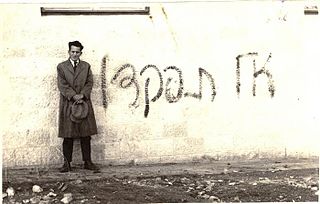 W
WThe 1931 census of Palestine was the second census carried out by the authorities of the British Mandate for Palestine. It was carried out on 18 November 1931 under the direction of Major E. Mills after the 1922 census of Palestine. No further census was conducted in Palestine by the British administration.
 W
WThe Anglo-American Committee of Inquiry was a joint British and American committee assembled in Washington on 4 January 1946. The committee was tasked to examine political, economic and social conditions in Mandatory Palestine as they bear upon the problem of Jewish immigration and settlement therein and the well-being of the peoples now living therein; to consult representatives of Arabs and Jews, and to make other recommendations 'as may be necessary' to for ad interim handling of these problems as well as for their permanent solution. The report, entitled "Report of the Anglo-American Committee of Enquiry Regarding the Problems of European Jewry and Palestine", was published in Lausanne on 20 April 1946.
 W
WThe Anglo-French Declaration was published by Great Britain and France, shortly after the Armistice of Mudros saw the capitulation of the Ottoman Empire. Some sources mention as publication date 7 November 1918, others 9 November 1918.
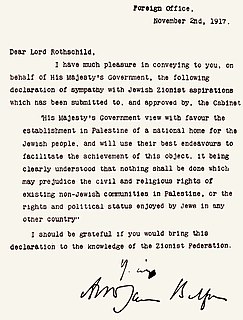 W
WThe Balfour Declaration was a public statement issued by the British government in 1917 during the First World War announcing support for the establishment of a "national home for the Jewish people" in Palestine, then an Ottoman region with a small minority Jewish population. The declaration was contained in a letter dated 2 November 1917 from the United Kingdom's Foreign Secretary Arthur Balfour to Lord Rothschild, a leader of the British Jewish community, for transmission to the Zionist Federation of Great Britain and Ireland. The text of the declaration was published in the press on 9 November 1917.
 W
WThe Bevin Plan, also described as the Bevin–Beeley Plan was Britain’s final attempt in the mid-20th century to solve the troubled situation that had developed between Arabs and Jewish people in Mandatory Palestine.
 W
WThe Cambon letter was an unpublished letter to Zionist diplomat Nahum Sokolow issued by the French government in 1917 during the First World War announcing support for the Zionist project in Palestine, then an Ottoman region with a small minority Jewish population. It read: You were good enough to present the project to which you are devoting your efforts, which has for its object the development of Jewish colonization in Palestine.You consider that, circumstances permitting, and the independence of the Holy Places being safeguarded on the other hand, it would be a deed of justice and of reparation to assist, by the protection of the Allied Powers, in the renaissance of the Jewish nationality in that Land from which the people of Israel were exiled so many centuries ago. The French Government, which entered this present war to defend a people wrongfully attacked, and which continues the struggle to assure the victory of right over might, can but feel sympathy for your cause, the triumph of which is bound up with that of the Allies. I am happy to give you herewith such assurance.
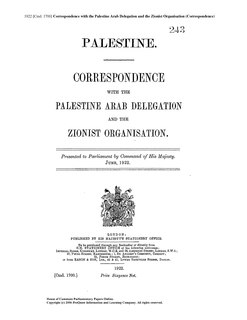 W
WThe Churchill White Paper of 3 June 1922 was drafted at the request of Winston Churchill, Secretary of State for the Colonies, partly in response to the 1921 Jaffa Riots. While maintaining Britain's commitment to the Balfour Declaration and its promise of a Jewish national home in Palestine, the paper emphasized that the establishment of a national home would not impose a Jewish nationality on the Arab inhabitants of Palestine. To reduce tensions between the Arabs and Jews in Palestine the paper called for a limitation of Jewish immigration to the economic capacity of the country to absorb new arrivals. This limitation was considered a great setback to many in the Zionist movement, though it acknowledged that the Jews should be able to increase their numbers by immigration as of right and not on sufferance.
 W
WThe Constitution of Mandatory Palestine, formally known as the 10 August 1922 Palestine Order-in-Council, was the codified constitution of Mandatory Palestine. It was first published on 1 September 1922 in an Extraordinary Issue of the Palestine Gazette.
 W
WThe Faisal–Weizmann Agreement was a 3 January 1919 agreement between Emir Faisal, the third son of Hussein ibn Ali al-Hashimi, King of the short-lived Kingdom of Hejaz, and Chaim Weizmann, a Zionist leader who had negotiated the 1917 Balfour Declaration with the British Government, signed two weeks before the start of the Paris Peace Conference. Together with a letter written by T. E. Lawrence in Faisal's name to Felix Frankfurter in March 1919, it was one of two documents used by the Zionist delegation at the Peace Conference to argue that the Zionist plans for Palestine had prior approval of Arabs.
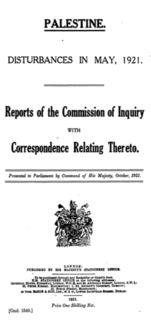 W
WThe Haycraft Commission of Inquiry was a Royal Commission set up to investigate the Jaffa riots of 1921, but its remit was widened and its report entitled "Palestine: Disturbances in May 1921". The report blamed the Arabs for the violence, but identified a series of grievances concerning the way their interests were apparently being subsumed to the interests of the Jewish immigrants, who were then around 10% of the population and increasing rapidly. Some measures to ease Arab unhappiness were taken, but Jewish communities were helped to arm themselves and ultimately the report was ignored. Publishing it was considered a propitiatory measure.
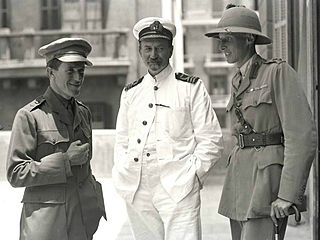 W
WThe Hogarth Message was a January 1918 message from Commander David Hogarth, head of the Arab Bureau in Cairo, to Hussein bin Ali, Sharif of Mecca, following Hussein's request for an explanation of the Balfour Declaration.
 W
WThe Report on Immigration, Land Settlement and Development, commonly referred to as the Hope Simpson Enquiry or the Hope Simpson Report, was a British Commission managed by Sir John Hope Simpson, established during August 1929 to address Immigration, Land Settlement and Development issues in British Mandate of Palestine, as recommended by the Shaw Commission, after the widespread 1929 Palestine riots.
 W
WThe King–Crane Commission, officially called the 1919 Inter-Allied Commission on Mandates in Turkey, was a commission of inquiry concerning the disposition of areas within the former Ottoman Empire.
 W
WThe Morrison–Grady Plan, also known as the Morrison Plan or the Provincial Autonomy Plan was a joint Anglo-American plan for the creation of a unitary federal trusteeship in Mandatory Palestine, announced on 31 July 1946.
 W
WThe Mandate for Palestine was a League of Nations mandate for British administration of the territories of Palestine and Transjordan, both of which had been conceded by the Ottoman Empire following the end of World War I in 1918. The mandate was assigned to Britain by the San Remo conference in April 1920, after France's concession in the 1918 Clemenceau–Lloyd George Agreement of the previously-agreed "international administration" of Palestine under the Sykes–Picot Agreement. Transjordan was added to the mandate after the Arab Kingdom in Damascus was toppled by the French in the Franco-Syrian War. Civil administration began in Palestine and Transjordan in July 1920 and April 1921, respectively, and the mandate was in force from 29 September 1923 to 15 May 1948.
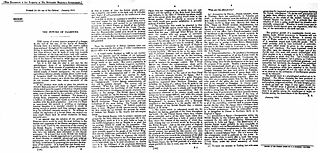 W
WThe Future of Palestine, also known as the Samuel memorandum, was a memorandum circulated by Herbert Samuel to the British Cabinet in January and March 1915, two months after the British declaration of war on the Ottoman Empire.
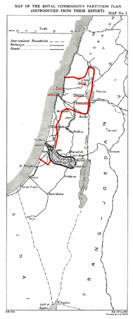 W
WThe Peel Commission, formally known as the Palestine Royal Commission, was a British Royal Commission of Inquiry, headed by Lord Peel, appointed in 1936 to investigate the causes of unrest in Mandatory Palestine, which was administered by Britain, following the six-month-long Arab general strike in Mandatory Palestine.
 W
WThe San Remo conference was an international meeting of the post-World War I Allied Supreme Council as an outgrowth of the Paris Peace Conference, held at Villa Devachan in Sanremo, Italy, from 19 to 26 April 1920. The San Remo Resolution passed on 25 April 1920 determined the allocation of Class "A" League of Nations mandates for the administration of three then-undefined Ottoman territories in the Middle East: "Palestine", "Syria" and "Mesopotamia". The boundaries of the three territories were "to be determined [at a later date] by the Principal Allied Powers", leaving the status of outlying areas such as Zor and Transjordan unclear.
 W
WThe Shaw Report, officially the Report of the Commission on the Palestine Disturbances of August 1929, commonly known as the Shaw Commission, was the result of a British commission of inquiry, led by Sir Walter Shaw, established to investigate the violent rioting in Palestine in late August 1929. The commission's report was issued in March 1930 and led to the establishment of the Hope Simpson Enquiry in May 1930. It concluded that the cause of the rioting was based in Arab fears of continual Jewish immigration and land purchases, particularly resonating from a growing Arab landless class. This was later reiterated in the Hope Simpson Enquiry and subsequent Passfield white paper, both which called for limited Jewish immigration to Palestine.
 W
WThe Statement of Information Relating to Acts of Violence was a White Paper published by the British Government on 24 July 1946. It was published as a request of the Prime Minister following the British Operation Agatha on 29 June 1946. Although it was published two days after the King David hotel bombing, it had been prepared prior to that event.
 W
WThe Survey of Palestine was the government department responsible for the survey and mapping of Palestine during the British mandate period. After 1948 it became the Survey of Israel.
 W
WThe Survey of Palestine was a two volume survey of Mandatory Palestine prepared between December 1945 and March 1946, as evidence for the Anglo-American Committee of Inquiry. A supplement was published in June 1947.
 W
WThe Sykes–Picot Agreement was a 1916 secret treaty between the United Kingdom and France, with assent from the Russian Empire and the Kingdom of Italy, to define their mutually agreed spheres of influence and control in an eventual partition of the Ottoman Empire.
 W
WThe Transjordan memorandum was a British memorandum passed by the Council of the League of Nations on 16 September 1922, as an addendum to the British Mandate for Palestine.
 W
WThe United Nations Partition Plan for Palestine was a proposal by the United Nations, which recommended a partition of Mandatory Palestine at the end of the British Mandate. On 29 November 1947, the UN General Assembly adopted the Plan as Resolution 181 (II).
 W
WThe White Paper of 1939 was a policy paper issued by the British government, led by Neville Chamberlain, in response to the 1936–1939 Arab revolt in Palestine. After its formal approval in the House of Commons on 23 May 1939, it acted as the governing policy for Mandatory Palestine from 1939 to the 1948 British departure. After the war, the Mandate was referred to the United Nations.